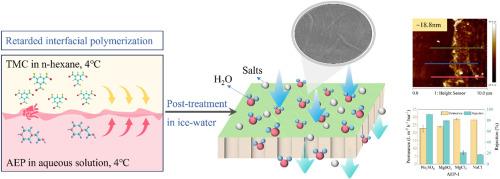通过缓速界面聚合法制备具有超薄选择层的聚(氨基乙基哌嗪)膜
IF 8.4
1区 工程技术
Q1 ENGINEERING, CHEMICAL
引用次数: 0
摘要
几十年来,人们一直在探索制造界面聚合薄膜复合膜的新单体。N-aminoethyl piperazine (AEP)是一种具有杂环结构的脂肪族胺,本研究采用它作为胺单体来合成纳滤膜。由于 AEP 具有高反应活性,因此采用了一种速率延缓的界面聚合方法,通过超低的 AEP 浓度(0.07 wt%)、低反应温度(4 °C单体溶液)和冰水淬火来实现。与通过热水后处理和烘箱热处理制备的膜相比,所制备的 AEP 膜性能要好得多(渗透率是其 3-4 倍,并具有封闭的排斥功能)。在单体浓度较低的情况下,通过速率滞后界面聚合法制备出了选择性层厚度仅为 20 纳米左右的 NF 膜。膜表面带负电荷,形态类似 "柳叶"。其截留分子量约为 200 g mol-1,透水率高达 22.8 L m-2 h-1 bar-1,与商用聚酰胺膜 NF270 不相上下。因此,AEP 是一种极具竞争力的 NF 膜合成替代单体。本文章由计算机程序翻译,如有差异,请以英文原文为准。

Poly-(aminoethyl piperazine) membranes with ultra-thin selective layers prepared via a rate-retarded interfacial polymerization method
New monomers have been exploring to fabricate interfacial polymerized thin film composite membranes for decades. N-aminoethyl piperazine (AEP), an aliphatic amine with a heterocyclic structure, was used in this work as an amine monomer to synthesize nanofiltration membranes. Due to the high reactivity nature of AEP, a rate-retarded interfacial polymerization method was applied, which was realized by applying ultra-low AEP concentration (0.07 wt%), low reaction temperature (4 °C monomer solutions), and ice-water quench. The resulting AEP membrane had much better performance (3–4 times permeance and closed rejections) compared with the membranes prepared by the hot water post-treatment and the oven heat treatment. At lower monomer concentrations, an NF membrane with a selective layer thickness of only around 20 nm was prepared by the rate-retarded interfacial polymerization method. The membranes had a negatively charged surface with "willow leaf" like morphology. The MWCO was around 200 g mol−1, and the water permeance was up to 22.8 L m−2 h−1 bar−1, which is comparable with the commercial polyamide membrane NF270. Therefore, AEP is a very competitive alternative monomer for NF membrane synthesis.
求助全文
通过发布文献求助,成功后即可免费获取论文全文。
去求助
来源期刊

Journal of Membrane Science
工程技术-高分子科学
CiteScore
17.10
自引率
17.90%
发文量
1031
审稿时长
2.5 months
期刊介绍:
The Journal of Membrane Science is a publication that focuses on membrane systems and is aimed at academic and industrial chemists, chemical engineers, materials scientists, and membranologists. It publishes original research and reviews on various aspects of membrane transport, membrane formation/structure, fouling, module/process design, and processes/applications. The journal primarily focuses on the structure, function, and performance of non-biological membranes but also includes papers that relate to biological membranes. The Journal of Membrane Science publishes Full Text Papers, State-of-the-Art Reviews, Letters to the Editor, and Perspectives.
 求助内容:
求助内容: 应助结果提醒方式:
应助结果提醒方式:


